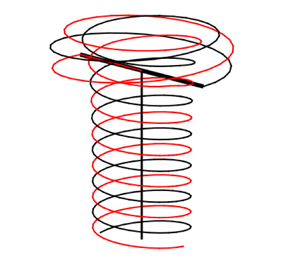Article contents
Structure and stability of Joukowski's rotor wake model
Published online by Cambridge University Press: 25 January 2021
Abstract

In this work, Joukowski's rotor wake model is considered for a two-blade rotor of radius  $R_b$ rotating at the angular velocity
$R_b$ rotating at the angular velocity  $\varOmega _R$ in a normal incident velocity
$\varOmega _R$ in a normal incident velocity  $V_{\infty }$. This model is based on a description of the wake by a limited number of vortices of core size
$V_{\infty }$. This model is based on a description of the wake by a limited number of vortices of core size  $a$: a tip vortex of constant circulation
$a$: a tip vortex of constant circulation  $\varGamma$ for each blade and a root vortex of circulation
$\varGamma$ for each blade and a root vortex of circulation  $-2\varGamma$ on the rotation axis. Using a free-vortex method, we obtain solutions matching uniform interlaced helices in the far field that are steady in the frame rotating with the rotor for a large range of tip-speed ratios
$-2\varGamma$ on the rotation axis. Using a free-vortex method, we obtain solutions matching uniform interlaced helices in the far field that are steady in the frame rotating with the rotor for a large range of tip-speed ratios  $\lambda = R_b \Omega _R/V_{\infty }$ and vortex strengths
$\lambda = R_b \Omega _R/V_{\infty }$ and vortex strengths  $\eta = \varGamma /(R_b^{2} \Omega _R)$. Solutions are provided for a two-bladed rotor for both helicopters and wind turbines. Particular attention is brought to the study of the solutions describing steep-descent helicopter flight regimes and large tip-ratio wind turbine regimes, for which the vortex structure is strongly deformed in the near wake and crosses the rotor plane. Both the geometry of the structure and its induced velocity field are analysed in detail. The thrust and the power coefficient of the solutions are also provided and compared to the momentum theory. The stability of the solutions is studied by monitoring the linear spatio-temporal development of a localized perturbation placed at different locations. Good agreements with the theoretical predictions for uniform helices and for point vortex arrays are demonstrated for the stability properties in the far wake. However, a more complex evolution is observed for the more deformed solutions when the perturbation is placed close to the rotor.
$\eta = \varGamma /(R_b^{2} \Omega _R)$. Solutions are provided for a two-bladed rotor for both helicopters and wind turbines. Particular attention is brought to the study of the solutions describing steep-descent helicopter flight regimes and large tip-ratio wind turbine regimes, for which the vortex structure is strongly deformed in the near wake and crosses the rotor plane. Both the geometry of the structure and its induced velocity field are analysed in detail. The thrust and the power coefficient of the solutions are also provided and compared to the momentum theory. The stability of the solutions is studied by monitoring the linear spatio-temporal development of a localized perturbation placed at different locations. Good agreements with the theoretical predictions for uniform helices and for point vortex arrays are demonstrated for the stability properties in the far wake. However, a more complex evolution is observed for the more deformed solutions when the perturbation is placed close to the rotor.
JFM classification
Information
- Type
- JFM Papers
- Information
- Copyright
- © The Author(s), 2021. Published by Cambridge University Press
References
REFERENCES
- 5
- Cited by


